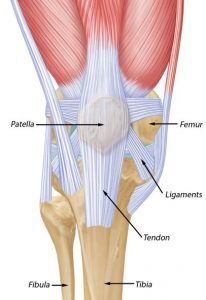Last Updated on October 27, 2023
The patella or kneecap is the sesamoid that lies within the quadriceps tendon/patellar ligament and forms part of the knee joint and is situated in front of the lower end of femur appx 1 cm above the knee joint. If it lies higher, it is called patella alta and if it is lower, it is called patella baja. It is the largest sesamoid bone of the body. The ossification centers of the kneecap appear between 3 and 6 years. They fuse at puberty, with higher levels of activity.
Structure
The patella is triangular in shape with a superior base and inferior apex. The apex lies about 1 cm from the knee joint. It has three borders – superior, lateral and medial, and two surfaces – anterior and posterior.
The anterior surface is convex, rough and ridged vertically. It is covered by expansion from tendons of rectus femoris and is separated from the skin by the prepatellar bursa.
The posterior surface is smooth, composed of articular cartilage, and is divided into medial and lateral facets. The posterior surface is articular in upper three fourths and nonarticular in its lower one fourth.
The articular area is divided by a vertical ridge into larger lateral and a smaller medial portion. Another vertical ridge separates a medial strip from the medial portion.
This medial strip articulates with a reciprocal strip on the medial side of intercondylar notch of the femur during full flexion.
The rest of the medial and lateral portions of the articular surface are divided by two transverse lines into three pairs of facets.
The medial and lateral facets of the patella articulate with the medial and lateral condyles of the femur, respectively, to form the patellofemoral component of the knee joint.
Attachments
The base [superior aspect or base of the triangle] provides insertion to rectus femoris in front and to vastus intermedius behind. The lateral border provides insertion to vastus lateralis in its upper one third to half. The medial border provides insertion to vastus lateralis in its upper third to half.
Behind the apex, on the posterior aspect, there is a nonarticular area which provides attachment to the patellar ligament or ligamentum patellae which get attached to the tibial tubercle, inferiorly.
Blood supply
Arterial blood enters via the anterior surface of the patella and an anastomotic patella ring is formed supplied by the paired superior and inferior geniculate arteries.
Determination of side of Patella
- A triangular with the apex of the triangle directed downwards.
- The anterior surface is rough and nonarticular. The upper three-fourths of the posterior surface is smooth and articular.
The bone rests on a broad lateral area when placed on a table as a vertical ridge divides it into the large lateral area and a smaller medial area.
During different phases of movements of the knee, different portions of the patellar bone articulate with the femur. The lower pair of articular facets articulates during extension, middle during flexion and upper pair during mid-flexion. Medial strip articulates during full flexion.
Clinical Significance of Patella
Lateral dislocation of the patella
The quadriceps muscle pulls the patella obliquely and laterally in relation to the femur. There are factors that prevent such displacement: larger lateral condyle of the femur, the tension in the medial retinacular fibers, and the direction of insertion of fibers of the vastus medialis muscle.
There is a natural tendency in the patella to dislocate laterally because of outward angulation of between the femur and tibia. This is prevented by the lateral edge of the patellar articular surface being deeper than the medial edge. Moreover, the vastus medialis inserts to a little lower than the vastus lateralis and keep the check.
A disturbance in bony anatomy or muscular balance may result in recurrent dislocation of the patella.
Injury
It is a common bone to be fractured.
Bipartite Patella
It is a condition where there is a failure of the fusion of the patella.


